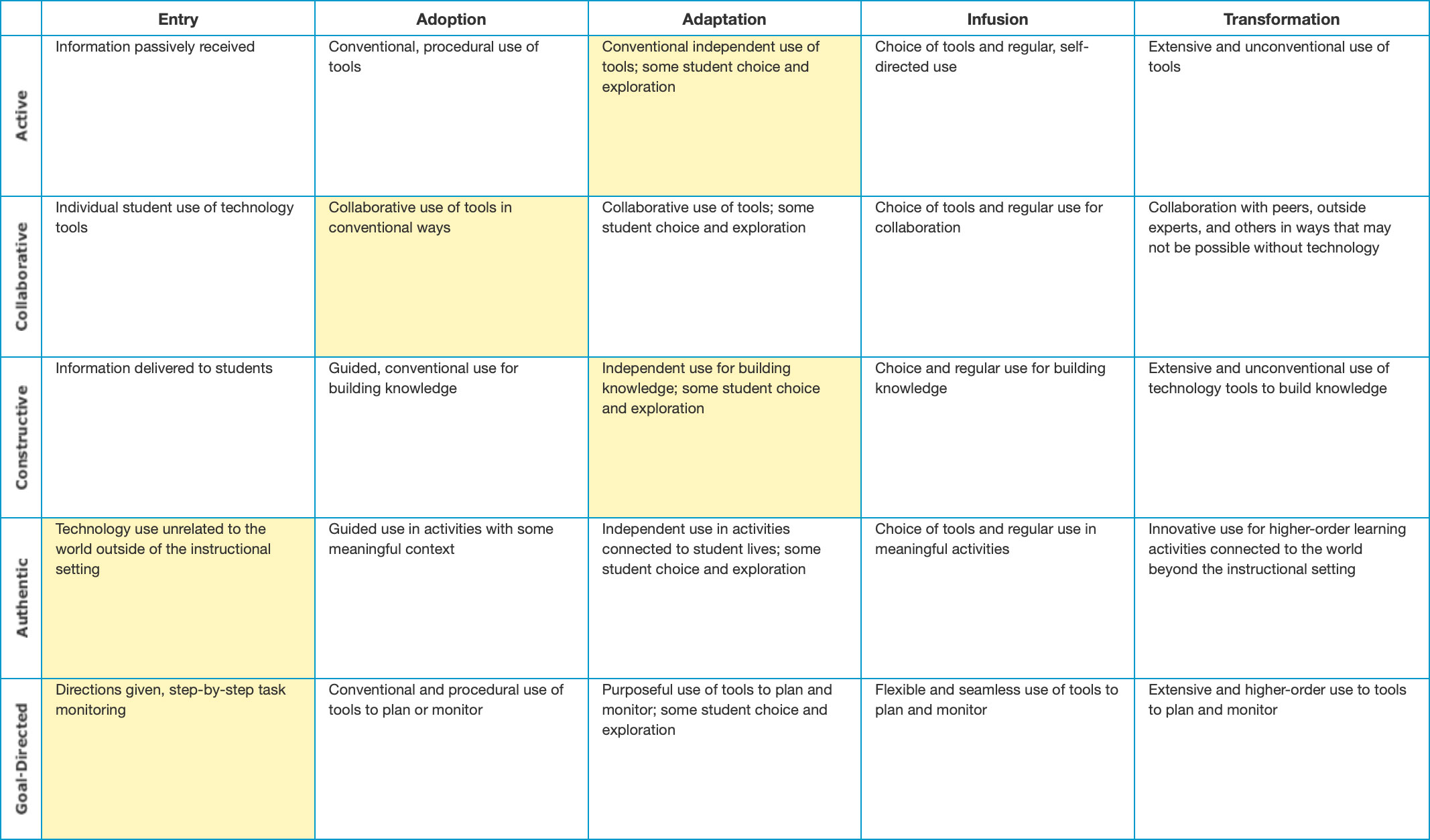
We’re often asked by PD departments, “What is the best way to train our teachers in using the Technology Integration Matrix?” Of course, there’s no one answer to that question, but in coming months, I plan to share some of the ideas we’ve found successful.
Before a school or district adopts the TIM model, it’s usually the case that teachers have been cajoled or at least strongly encouraged to “USE MORE TECHNOLOGY!” Or sometimes the mandate is to use some e-learning system that the school has just purchased from a sales rep who claimed test scores would rise. The push to use more or to use new tech can sometimes lead to unintended results. Some teachers who have been around awhile will decide just to nod politely and wait out the latest “fad.” Other teachers may adopt the new tech, but allow it to overshadow the good teaching practices they already were doing.
That’s why I think the TIM is so important—it’s about using technology, but the focus is on effective teaching practices not on the tech itself.
One way to get teachers past the “more tech makes better lessons” thinking is to ask them to adapt an existing lesson to move it up one level for any specific characteristic on the TIM. For example, maybe they are starting with a lesson that has the following TIM profile:
Active: Adaptation
Collaborative: Adoption
Constructive: Adaptation
Authentic: Entry
Goal-Directed: Entry
Click thumbnail image to enlarge.
Changing the lesson so that the Collaborative characteristic moves from the Adoption level to the Adaptation level will reinforce the notion that it’s not just about HOW MUCH technology is used in the lesson, but rather about HOW the technology is used in the lesson. Adjustments to the lesson may have to be made in what the teachers does, what the students do, and in the instructional setting. For the example of moving the Collaborative characteristic from Adoption to Adaptation, the lesson would have to be modified so that:
- The students have more independence in their use of collaborative tools.
- The teacher builds in an opportunity for the students to be able to explore the use of the collaborative tools themselves, rather than just following the conventional process they’ve previously been taught.
- The setting provides a greater access for multiple students to access the technology simultaneously. In other words, there a little less control on the part of the teacher about what tools students have access to.
Then, of course, you’d want teachers to share their revised plans and defend their choices to the group of teachers you are training. Others in the group will probably have suggested improvements to the plan. If each teacher in the group has worked on different levels or different characteristics, the sharing and discussion will give everyone involved a much better understanding of some of the underlying characteristics of the TIM. It may be helpful for you to have reviewed the post, The Invisible Technology Integration Matrix, but a quick summary is that as lessons move up levels in the technology integration they:
- Move from an instructional focus on the tech to an instructional focus on the content.
- Move from teacher ownership of learning to student ownership of learning.
- Move from procedural understanding of the technology used to a conceptual understanding.
- Move from simple use of tech tool to more complex use.
- Move from conventional use of tools to more innovative use.
Leading a discussion that aims to identify some of these underlying principles will help cement the teachers’ understanding of the rationale of the TIM.
Depending on the amount of time you have with the teachers and their prior exposure to the TIM, you may want to follow up with variations of the activity:
- Teachers can be asked to revise the lesson so that multiple characteristics move up a level.
- Or they may be asked to move a lesson up more than one level.
- They can also be asked to move a lesson down a level. This activity is not only a useful experience, it also reinforces the notion that a lesson at any particular level may be best in terms of the students’ preparation, the curriculum demands, and available technology. It’s certainly never wise to suddenly drop a higher-level lesson on students who are not prepared for it. In my role as a classroom observer, I’ve seen some disasterous results when a teacher attempted to show-off by conducting a lesson that the students were completely unprepared for.
Roy Winkelman is a 40+ year veteran teacher of students from every level kindergarten through graduate school. As the former Director of FCIT, he began the Center's focus on providing students with rich content collections from which to build their understanding. When not glued to his keyboard, Dr. Winkelman can usually be found puttering around his tomato garden in Pittsburgh.
Want To Know More?
Schedule a personal walk-through of the TIM Tools for yourself or your staff. See how this flexible set of technology integration tools will meet your school or district's specific needs.

